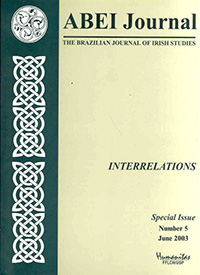Urban and Intellectual Beauty: Aspects of Oscar Wilde’s Influence
DOI:
https://doi.org/10.37389/abei.v5i1.182429Keywords:
Oscar Wilde, Chinese literature, Irish Literature, Chinese authorsAbstract
In the 1920s and 1930s, Chinese scholars exalted Oscar Wilde as a worthy model for others to follow. His ideas about freedom, iconoclasm, and passion without limits tremendously influenced Chinese intellectuals, more so than did his dramatic techniques. This paper examines the literary influence of Salomé on certain Chinese literary works. The Chinese intellectuals of the era understood the fatal physical desires and the meaning and consequence of ultimate defiance in Salomé, but they also saw her invincibility, which in turn was thought to be helpful in achieving breakthroughs in a traditional feudalistic society. In those days, the play was regarded as an unconventional discourse that exemplified a radical personality that was deemed to be suitable for China. The Chinese stories are all set in cities that foreground the individual’s search for assertion and love. Salomé, instead of being a femme fatale, is redefined with a positive and rational attitude that reflects a deeper concern for the role of intellectuals. The transformation is fueled by the desire to affect a change in cultural consciousness in terms of the search for one’s role and the striving for freedom, especially for women. An intellectual and bourgeoisie overtone is apparent in these stories, and it is connected to the underlying urban discourse. The indebtedness to Wilde is more a kind of inspiration than a blind imitation. By studying Salomé’s literary representations in selected Chinese works and by investigating the poetical devices and treatment of certain themes in relation to the sociocultural and intellectual concerns of the Chinese authors, I hope to broaden our understanding on major intellectual concepts in those days.
References
Bai Wei, and Yang Sao. Zuoye [Last Night]. Hebei: Hebei jiaoyu chubanshe, 1995.
Brown, Julia Prewitt. Oscar Wilde’s Philosophy of Art. Charlottesville: University Press of Virginia,
Ding, Xiaoping. “‘Danse xiangxiang’ de jingjie: Du ‘Misangsuoluopu zhi yege’” [The state of
monochromatic imagination: Reading ‘Misanthrope’s night song’], in Guo Moruo shici jianshang
[Appreciation of Guo Moruo’s poetry]. Hebei: Hebei renmin chubanshe, 1984.
Donohue, Joseph. “Distance, Death and Desire in Salome”, in Peter Raby (Ed.). The Cambridge
Companion to Oscar Wilde. Cambridge: Cambridge University Press, 1997.
Ellmann, Richard. “Overtures to ‘Salome’”, in Harold Bloom (Ed.). Oscar Wilde. New York: Chelsea
House, 1985.
Findeisen, Raoul David. “From Literature to Love: Glory and Decline of the love-letter Genre”, in
Michel Hockx, (Ed.). The Literary Field of Twentieth-century China. Surrey: Curzon, 1999.
Friedman, Jonathan. Cultural Identity and Global Process. London: Sage, 1994.
Fruehauf, Heinrich. “Urban Exoticism in Modern and Contemporary Chinese Literature”, in Ellen
Widmer; David Der-wei Wang (Ed.). From May Fourth to June Fourth: Fiction and Film in
Twentieth-Century China. Massachusetts: Harvard University Press, 1993.
Guo, Moruo. “Misangsuoluopu zhi yege” [Misanthrope’s night song], in Zhang
Xuezhi (Ed.). Guo Moruo daibiaozuo [Representative Works of Guo Moruo]. Henan: Huanghe wenyi
chubanshe, 1990.
____. “Si de youhuo” [The temptation of death], in Zhang Xuezhi (Ed.). Guo Moruo daibiaozuo
[Representative Works of Guo Moruo]. Henan: Huanghe wenyi chubanshe, 1990.
Huters, T. D. “Critical Ground: The Transformation of the May Fourth Era”, in Bonnie McDougall
(Ed.). Popular Chinese Literature and Performing Arts in the People’s Republic of China 1949-
California: University of California Press, 1984.
Kellogg-Dennis, Patricia. “Oscar Wilde’s Salome: Symbolist Princess”, in C. George Sandulescu
(Ed.). Rediscovering Oscar Wilde. Cornwall: Colin Smythe, 1994.
Lee, Leo Ou-fan. Shanghai Modern: The Flowering of a New Urban Culture in China, 1930-1945.
Massachusetts: Harvard University Press, 1999.
Lefevere, Andre. “Translation Practice(s) and the Circulation of Cultural Capital: Some Aeneids in
English”, in Susan Bassnett and Andre Lefevere (Ed.). Constructing Cultures: Essays on Literary
Translations. Clevedon: Multilingual Matters, 1998.
Lin, Weiyin. “Bai qiangwei” [White rose], in Liu Qinchuan (Ed.). Zhongguo xiandai weimeizhuyi
wenxue zuopinxuan [Selected works of modern Chinese aestheticism]. V. 2. Guangzhou: Huacheng
chubanshe. The NIV [New International Version] Study Bible (1985). Michigan: Zondervan, 1996.
Paglia, Camille. Sexual Personae: Art and Decadence from Nefertiti to Emily Dickinson. London:
Penguin, 1991.
Price, Jody. A Map with Utopia: Oscar Wilde’s Theory for Social Transformation. New York: Peter
Lang, 1996.
Sammells, Neil. Wilde Style: The Plays and Prose of Oscar Wilde. Singapore: Pearson Education,
Shih, Shu-mei. The Lure of the Modern: Writing Modernism in Semicolonial China, 1917-1937.
Berkeley: University of California Press, 2001.
Tien Gu. “Shixiang de fuhuo” [The Resurrection of the statue], in Xu Junwei (Ed.). Tien Gu xiaoshuo
quanbian [Complete Fiction of Tien Gu]. Shanghi: Xuelin chubanshe, 1997.
Varty, Anne A Preface to Oscar Wilde. New York: Longman, 1998.
Wilde, Oscar/ Salomé, in Plays/Oscar Wilde. Middlesex: Penguin, 1960.
Wong, Linda Pui-ling. “The Initial Reception of Oscar Wilde in Modern China: With Special Reference
to Salomé”, in Comparative Literature & Culture 3 (September), 1998.
Xu, Jingan. “Weimeizhuyi zai zhongguo de chuanbo, jieshou he bianyi” (Aesthetics, Its Spread,
Acceptance and Variation in China), in Zhongwai wenhua yu wenlun (Chinese-Foreign Cultures
and Literary Theories). V. 2. Chengdu: Sichuan daxue chubanshe, 1996.
Yang, Cunren. “Xiju” [Drama], in Jindai zhongguo yishu fazhanshi [History of
development of modern Chinese art]. Shanghai: Shanghai shudian chubanshe, 1989.
Yang, Sao. “Introduction”, in Bai Wei and Yang Sao, Zuoye [Last Night]. Hebei: Hebei jiaoyu
chubanshe, 1995.
Zhang, Kebiao. “Shenlou” [The mirage], in Liu Qinchuan (Ed.). Zhongguo xiandai weimeizhuyi
wenxue zuopinxuan [Selected works of modern Chinese aestheticism]. V. 2. Guangzhou: Huacheng
chubanshe, 1996.
Zheng, Junli. “Dianying” [Film], in Jindai zhongguo yishu fazhanshi [History of development of
modern Chinese art]. Shanghai: Shanghai shudian chubanshe, 1989.
Zhou, Xiaoyi. “Oscar Wilde: An Image of Artistic Self-Fashioning in Modern China, 1909-1949”, in
Hua Meng and Sukehiro Hirakawa (Ed.). Images of Westerners in Chinese and Japanese Literature.
Amsterdam: Rodopi, 2000.
Downloads
Published
Issue
Section
License
Copyright (c) 2003 Linda Wong

This work is licensed under a Creative Commons Attribution-NonCommercial 4.0 International License.


